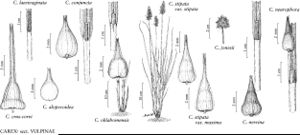Carex neurophora
in L. Abrams and R. S. Ferris, Ill. Fl. Pacific States 1: 298, fig. 706. 1923.
Plants with basal sheaths of previous year not persistent. Culms to 60 cm × 1.5 mm, scabrous. Leaves: sheaths usually all with blades; proximal 2–3 sheaths to 10–15 cm with reduced blades shorter than sheath, green, fronts herbaceous, prominently veined, not splitting, apex truncate, fronts of distal sheaths hyaline, rugose, indistinctly linearly veined, apex colorless, hyaline, convex, entire; ligules obtuse, 1.5 mm, free limb to 0.1 mm; blades not clustered at base, not epistomic, to 40 cm × 5 mm. Inflorescences very condensed, ovoid or shortly cylindric, with 5–10 indistinguishable branches, to 2.5 × 1.5 cm; proximal internode not visible, not more than 3 mm; proximal bract scalelike, inconspicuous. Scales hyaline, brown, distinctly shorter than perigynia. Perigynia pale-brown, 9–11-veined abaxially, 5–7-veined adaxially, to 3.5 × 1.5 mm, base distended only slightly proximally, cordate; stipe to 0.2 mm; beak to 2 mm, margins serrulate, apex bidentate, teeth to 0.1 mm. Achenes obovate, to 1.5 × 1 mm; stalk to 0.2 mm; persistent style base cylindric.
Phenology: Fruiting Aug.
Habitat: Wet subalpine meadows, stream banks
Elevation: 1000–3200 m
Distribution

Colo., Idaho, Mont., Oreg., Wash., Wyo.
Discussion
Selected References
None.
Lower Taxa
"shortened" is not a number."not undefined" is not a number.
